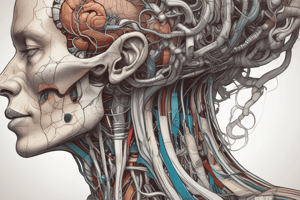Podcast
Questions and Answers
What is the total volume of air that can be moved in and out of the lungs in a single maximal breath?
What is the total volume of air that can be moved in and out of the lungs in a single maximal breath?
- Tidal Volume (TV)
- Expiratory Reserve Volume (ERV)
- Vital Capacity (VC) (correct)
- Inspiratory Reserve Volume (IRV)
Which disease causes alveoli to become brittle and rupture?
Which disease causes alveoli to become brittle and rupture?
- Emphysema (correct)
- Environmental contaminant inhalation
- Pulmonary fibrosis
- Hardening of the lungs
What are the four tunics of the GI tract wall (deep to superficial)?
What are the four tunics of the GI tract wall (deep to superficial)?
- Mucosa, Muscularis, Submucosa, Serosa
- Mucosa, Submucosa, Muscularis, Serosa (correct)
- Submucosa, Mucosa, Serosa, Muscularis
- Serosa, Muscularis, Submucosa, Mucosa
What structure extends posteriorly from the soft palate that elevates during swallowing to close off the posterior entrance to the nasopharynx?
What structure extends posteriorly from the soft palate that elevates during swallowing to close off the posterior entrance to the nasopharynx?
What is the thin flap of tissue anchoring the tongue to the floor of the oral cavity?
What is the thin flap of tissue anchoring the tongue to the floor of the oral cavity?
Flashcards
Vital Capacity (VC)
Vital Capacity (VC)
The maximum volume of air that can be inhaled and exhaled in a single breath.
Emphysema
Emphysema
A lung disease characterized by the destruction of alveoli, leading to reduced lung capacity and difficulty breathing.
Mucosa
Mucosa
The innermost lining of the digestive tract, composed of epithelium, lamina propria, and muscularis mucosae.
Uvula
Uvula
Signup and view all the flashcards
Lingual frenulum
Lingual frenulum
Signup and view all the flashcards




